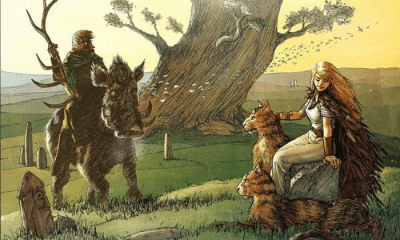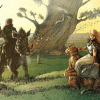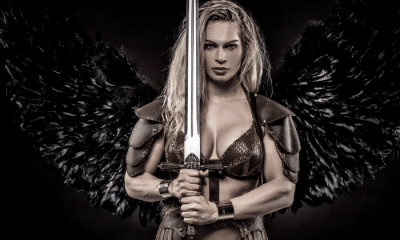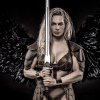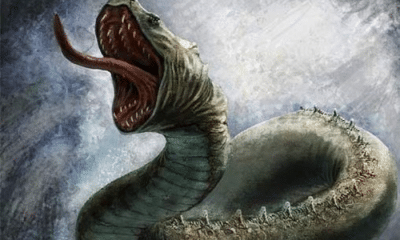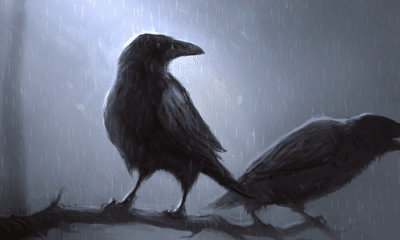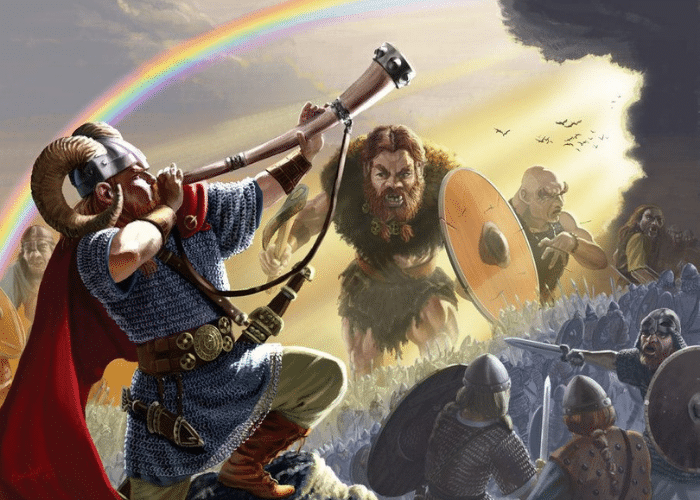
Norse
Who Was Heimdall in Norse Mythology?
Who Was Heimdall in Norse Mythology?
The Norse god Heimdall is best known as the watchman at the rainbow bridge, but is there more to the god than his role as a guardian? Keep reading to find out!
The most iconic image of the Norse god Heimdall is of him blowing his great horn to announce the beginning of Ragnarok. The watchman of the Bifrost bridge, he sounded the alarm that alerted the Nine Worlds to the last battle.
While this was certainly an important part of Heimdall’s story, there is much more to the god than his role as the watcher on the bridge.
Heimdall appeared in many well-known myths, often in a supporting role. While many of these appearances may seem small, collectively they make him one of the most well-attested gods in the Norse pantheon.
Those appearances also show that Heimdall’s role was much larger than that of a typical guardian. He had connections to many gods, elements, and aspects of the human world.
Even though Heimdall is remembered for blowing his horn, the evidence found in the legends surrounding him show that he might have actually been one of the most important gods in Norse mythology.
The Nine Mothers of Heimdall
Heimdall was said to have been the son of Odin and nine mothers.
While earlier sources do not name these mothers, a later source lists the nine women by name. It says that all nine bore him and he was born with the strength of the earth and the ice of the sea.
Although it is not clearly stated in the source, the mention of the sea has led some historians to speculate about the precise identities of Heimdall’s mothers.
Aegir and Ran are sometimes mistakenly referred to as the god and goddess of the sea, but they were actually jotnar. They were friends of the gods and famously hosted a feast at which several preeminent deities, including Heimdall, were present.
- One source mentions that Aegir and Ran had nine daughters. Like the nymphs of Greek mythology, these daughters of the sea’s ruler personified the waves.
Many people believe that the nine daughters of Aegir were also the nine mothers of Heimdall. They are the only grouping of nine women mentioned in surviving Norse sources and this interpretation would fit the idea of Heimdall’s birth involving the sea.
Most sources agree, however, that his father was Odin. This made him a half-brother to the most prominent Aesir gods, including Baldur and Thor.
It is also of note that the connection between Odin and the number nine has importance beyond Heimdall’s birth.
The number appears often in texts and images that have magical significance. When Odin sacrificed himself, for example, he hung from Yggdrasil for nine days. The journey to Hel also took nine days on Sleipnir and there were Nine Worlds in Norse cosmology.
The union of Odin and the number nine, therefore, would seem to imply that the birth of Heimdall had particular significance. Unlike other gods, whose parentage is more typical or not mentioned at all, from birth Heimdall seems to have been set apart as a particularly powerful or influential figure.
Sounding the Horn
Of all the myths he appears in, the most familiar to many people is the role he will play in Ragnarok. The image of Heimdall as the battle begins is so iconic that it has appeared in art and even on postage stamps for centuries.
One of Heimdall’s roles was as the watchman of the gods. He is called their warden and his superior senses are mentioned several times.
He lived in a castle called Himinbjorg. It was positioned at the Asgardian end of the Bifrost bridge so Heimdall would be immediately aware if anyone tried to enter the world of the gods.
This would be the case in the events leading up to Ragnarok. After three years of winter, the many bound monsters who had troubled the gods in the past would break free and swarm over Midgard.
The fire giants of Muspelheim, led by their terrible commander Surt, would march across the land until they reached the Bifrost. When they began to cross it, Heimdall was immediately aware.
Heimdall blew his great horn, the Gjallarhorn, to alert the other gods to the invasion. The horn being blown signaled the official beginning of Ragnarok, the last battle of the gods.
According to the Prose Edda, each of the gods faced a different opponent on the battlefield. Heimdall did not face a monster, but Loki himself.
Loki had once been a friend of the gods, but his mischievous behavior had become increasingly malicious until he directly caused the death of Baldur. He was bound, as were his monstrous children.
Loki and his offspring were the primary antagonists of Ragnarok. Some scholars believe that other monsters, such as Surt, were added by later writers and Loki’s family were originally the only enemies of the tale.
For Heimdall to face off against Loki, therefore, means that he was positioned against the source of the threat. Loki was not the physically strongest enemy, but he was their father and leader.
As with many of these pairings, the fight would end in mutual destruction. Heimdall and Loki would kill one another, neither surviving the last battle.
Heimdall’s Hearing
Because of its importance in the narrative of Ragnarok, Heimdall’s horn is often his defining attribute. There are details in the surviving sources that make this horn an even more interesting topic of discussion for historians, though.
Heimdall’s horn is not the only one by the name of Gjallarhorn mentioned in texts. This is unusual, as the names of items were typically as unique as the names of the gods who carried them.
The other Gjallarhorn belonged to Mimir, the disembodied head of the god of memory. It was not, however, used in the same way Heimdall’s was.
Mimir used his Gjallarhorn as a drinking vessel. Each day, according to some sources, he took a drink from the well that contained all the knowledge of the world. On one occasion, he allowed Odin to drink from this magical water as well.
Some scholars believe that the two horns may have been one and the same. Gjallarhorn may have been the drinking vessel that gave Odin some of his knowledge and then been used to announce Ragnarok, the event that his knowledge had informed him of.
One clue to this is in a passage from the Poetic Edda that describes the knowledge of the volva, or seeress, who told Odin what would come to pass at Ragnarok. She said, according to some translations, that Heimdall’s horn was beneath the sacred tree, Yggdrasil.
This would be in keeping with its identification as the horn Mimir used. His well, too, was beneath one of Yggdrasil’s roots.
Some more recent translations, however, have called this classical interpretation into question.
The word used in the original Old Norse text is hljóð, which has traditionally been translated as “horn.” Some linguistic scholars have noted, however, that this word is not used for a horn anywhere else in Old Norse texts.
Instead, they theorize that a more likely translation is “hearing.” The passage then reads:
She knows that Heimdall’s hearing is hidden
under the radiant, sacred tree;
she sees, pouring down, the muddy torrent
from the wager of Father of the Slain; do you
understand yet, or what more?
-Poetic Edda, Völuspá (trans Larrington)
“Heimdall’s hearing” would make little sense in this context if it weren’t for the fact that another god had also once left one of his senses beneath the tree.
When Odin drank from Mimir’s Well, he had to sacrifice something of himself. He pulled out one of his eyes and threw it into the water, leading later sources to sometimes say that Odin’s sight was left there.
A possible interpretation of this passage, therefore, is that the Gjallarhorn was not what Heimdall left at Mimir’s Well. He may have made a sacrifice, like Odin, and lost an ear.
If this is the case, it furthers the argument that Heimdall was intrinsically linked to concepts of magic, the type of knowledge that Odin was always in pursuit of. It also makes it clear that he was far more than just the guardian of the bridge to Asgard.
Many stories in Norse mythology seem to allude to the events of Ragnarok even if the connection is not clearly made. This may be one such case, as Heimdall likely would have heard the fire giants before they crossed the Bifrost if he had not given up an ear.
While this is a new interpretation that is not accepted by all scholars, it opens up the possibility of Heimdall being a far more major figure in Norse mythology than was once thought.
Names and Kennings
Like other gods in Norse mythology, Heimdall was known by a variety of names.
Many of these were kennings, a type of poetic description common in Norse culture. These kennings were designed to not only showcase the poet’s talent but also to test the knowledge of the listener or reader.
These kennings often refer to some of Heimdall’s most well-known legends. He is called, for example, “Loki’s enemy” or “son of nine mothers.”
Unlike some other gods, however, Heimdall was also occasionally referred to by other names entirely. While the kennings and other titles are usually easy to understand, some of Heimdall’s names have never been translated.
They include:
- Hallinskidi: This name is obscure and no definite translation has been made. Some believe that it may come from a term for asymmetrical horns and harken back to an earlier ram god.
- Gullintani: “The one with golden teeth.” Gold was also called “Heimdall’s teeth” in kennings.
- Vindler: Also spelled Vindhler, this could mean “wind sea” or “one who protects against the wind.” This has been taken as further evidence that Heimdall was the son of sea goddesses.
Like his alternative names, Heimdall’s own has not been able to be translated directly.
A prominent theory is that the name may roughly translate as “one who illuminates the world.” This, in conjunction with his kennings and myths, has led to some theories about Heimdall’s origins.
Because the name does not have a direct translation in Old Norse or another early Germanic language, it is likely that Heimdall emerged as a character before these languages were spoken. This would mean that he was a much older figure than some other gods and creatures in Norse mythology.
Several of Heimdall’s kennings and names refer to gold. This is not uncommon in Old Norse, but in many cultures gold was specifically linked to the sun.
Further connections to the sun can be seen in the theory that Heimdall was once associated with rams. In many cultures, such as Egypt, ram-headed gods represented the sun.
Heimdall may have also risen from the sea. This is common with many dawn goddesses and early sun deities because the sun often rose over the water from the perspective of seaside communities.
These kennings, combined with the possible interpretation of Heimdall’s name referring to light, could indicate that he was once thought of as a sun god. Although this domain was no longer entirely maintained, traces of it remained in the language.
A trace may have also remained in Heimdall’s famous post. He was positioned as guardian of the Bifrost bridge, which was often depicted as a rainbow.
The other god most closely linked to stories of the Bifrost was Thor, the thunder god, who swam through boiling water rather than walk across the Bifrost. If Heimdall was once a sun god, these two would represent the sun and rain, the elements needed to make a rainbow appear.
Heimdall and Mankind
Another name Heimdall was sometimes known by was Rig. This was not a poetic name or an alternative, however, but an alias.
Like Odin, Heimdall sometimes went to Midgard in the guise of a human. When he did so, he used the name Rig.
A Danish poem recounts Heimdall’s most famous visit to Midgard as Rig and the effects it had on human culture.
According to the legend, in the early days of humanity Heimdall took on the persona of Rig to see how mankind lived. He wandered the roads, staying with several families as he traveled.
He enjoyed the custom of hospitality with each household for three nights before continuing on his way. To each couple he stayed with he gave valuable advice on how to manage their properties and go about their labors.
Outside of this custom, he also spent one of those nights with the wives of each household. Nine months later, three children were born.
The first child, Thraell, was brutish and ugly. He became the ancestor of the thralls, Norse culture’s lowest class of slaves.
Rig’s second son was Jarl. He was strong and hearty and became the ancestor of free farmers and laborers.
The third boy was Karl, the ancestor of warriors. He was a handsome boy who loved adventure, hunting, and fighting.
Some years later, Jarl had a son of his own. Kon was not only a brave fighter like his father, but was also exceptionally wise and just.
Rig reappeared that day and adopted his grandson as his own. He taught Kon to read and write runes before telling him to strike out and claim land of his own.
Kon became the ancestor of kings and chieftains. His descendants were not only great warriors, they were also wise and well-educated men.
Heimdall was therefore not the first ancestor of humanity, but he was the origin of Norse culture’s social classes. He was honored in poems and kennings as having sway over mankind and the Poetic Edda called all of humanity “sons of Heimdall.”
Interpreting the God
While many cultures made the domains of their gods quite clear, pagan Norse religion was often more obscure. Each god was associated with specific things, but many gods had uncertain domains.
Heimdall, in particular, has provided a puzzle for historians. While his role as the gods’ watchman is clear, there is evidence that he was a much more prominent figure.
He is mentioned in surviving texts more than many of the other gods. In addition to stories like that of Rig that center around him, he also plays an important role in tales of other gods.
When Thor’s hammer Mjollnir was stolen, for example, it was Heimdall who proposed the ploy that allowed the thunder god to get it back. In that instance he was described as having the gift of foresight, a trait typically associated with magic-users.
In a similar story, Freya sought his help when her necklace, Brisingamen, was stolen. He tracked down the thief, Loki who had disguised himself as a seal to hide, and shapeshifted to fight him and win back Freya’s torc.
This story not only shows Heimdall’s ability to shapeshift and fight, but also links him to Freya. While he is not otherwise mentioned in connection to the well-loved goddess, one account of Ragnarok suggests that he wears her necklace into battle.
In other instances, he was described as being the brightest of the Aesir with skin that was a pure white color. Such descriptions of radiance are often used for especially honored and noble gods, particularly Baldur.
Heimdall is also the primary god, after Odin, who is credited with having a hand in the creation of mankind. The fact that humanity is called “Heimdall’s sons” shows the importance placed on his role.
Creator gods are often among the most prominent in their pantheons. Identifying Heimdall with the creation of mankind as the ancestor of the social classes likely implies that he was seen as a major god.
Heimdall’s battle against Loki in the final fight of Ragnarok also implies a high level of importance. Fenrir was the most dangerous enemy in a physical fight, but Loki had played a major role in many stories as the gods’ former friend and later antagonist.
Most historians believe that many of the details of Ragnarok in the Prose Edda were inventions of the author, who lived long after his native Iceland had been officially Christianized. Heimdall’s enmity with Loki, however, is mentioned in several other sources.
These details all give historians the impression that Heimdall was far more than the watchmen of the gods. Even if his characterization had been changed over time, it is clear that, at least at some point, Heimdall was one of the pantheon’s most powerful gods.
The Importance of Heimdall
The Norse god Heimdall appears in many texts. Collectively, they make him one of the most well-attested gods of Norse mythology.
He is best remembered for blowing the horn that announced the beginning of Ragnarok. Positioned to guard the Bifrost bridge, he was the first to see enemy forces advancing toward Asgard.
While this characterization of the watchman of the gods is Heimdall’s most well-known duty, other stories show that he was likely a god with a much broader domain.
His name, as well as many of the alternatives sometimes used, seems to refer to the sun. This is possibly reinforced by a further association with gold.
He is also connected to the sea. The most likely identification for Heimdall’s nine mothers are the daughters of Aegir and Ran, a group of nymph-like sea jotnar.
Stories show Heimdall as an ancestor to most of humanity. He had three human sons who became the ancestors of the Viking Age social classes.
He is connected to Odin, who was his father, and to the ideas of magic and knowledge that are often seen in Odin’s myths.
Finally, at Ragnarok Heimdall was paired against perhaps the gods’ greatest enemy. While Loki was not the most dangerous to fight, his prominence as an antagonist of the gods made him their most constant foe.
All of this evidence points to the fact that Heimdall was likely a very prominent god in the Norse pantheon. Although now characterized as the guard stationed at the bridge, he was likely one of the most powerful of the Aesir gods.


